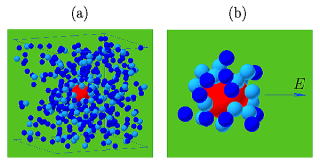(gelatin, paint, etc.) and the constituents of living objects including proteins and
the DNA. The soft condensed matters represent polymers and colloidal solutions.
Here we introduce our recent studies of "ionic soft condensed matters, the
characters (structures and functions) of which are highly influenced by strong
electrostatic forces.
In these ionic materials, the net electrostatic energy that brings forth structure
exceeds thermal energy that tends to destroy the structure about several times at
room temperature. Interestingly, even if the material is electrically neutral,
the attraction force overcomes the repulsive force since the positive and negative
ions recognize each other and have the tendency of forming ion pairs.

Figure: A charge inverted macroion, (a) All ions, (b) the blowup of the vicinity
of the macroion are displayed. The macroion is a large red sphere, counterions
and coions are light and dark blue spheres, respectively - Euro.Phys.J., E.,
p. 371-379 (2002).
The ionic soft condensed matters belong to "strongly coupled Coulomb system".
However, because of the electrostatic energy dominance over thermal energy by
only several times, the softness (or stiffness) of these materials can be controlled
by environmental conditions such as the amount of salt (ionic strength),
pH (concentration of hydrogen ions). We can make good use of these properties
in applications to daily products. It might be the case with biochemical processes
including DNA and proteins to enable flexible structure changes for storage and
reproduction of themselves at the room temperature.
With this regard, the ionic soft condensed matters are very attractive and have wide
range of physical and chemical applications. For example, the charge inversion
phenomenon, described in the next section, is expected to be used in gene therapy
for delivery of negatively charged DNA to living cells having negative electrostatic
potentials.
Topics
1.Charge Inversion of a Macroion in Solvent
2.Electrolyte (Charged) Polymers - Polyampholyte
3.DNA in Nanopore
4.Microwave Heating of Water and Ice